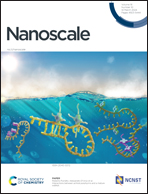Exploiting cyclodextrins as artificial chaperones to enhance enzyme protection through supramolecular engineering†
Abstract
We report a method of enzyme stabilisation exploiting the artificial protein chaperone properties of β-cyclodextrin (β-CD) covalently embedded in an ultrathin organosilica layer. Putative interaction points of this artificial chaperone system with the surface of the selected enzyme were studied in silico using a protein energy landscape exploration simulation algorithm. We show that this enzyme shielding method allows for drastic enhancement of enzyme stability under thermal and chemical stress conditions, along with broadening the optimal temperature range of the biocatalyst. The presence of the β-CD macrocycle within the protective layer supports protein refolding after treatment with a surfactant.



 Please wait while we load your content...
Please wait while we load your content...